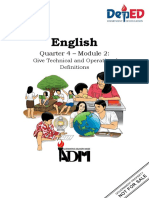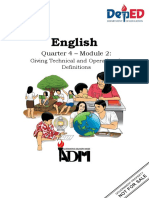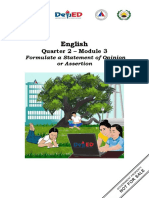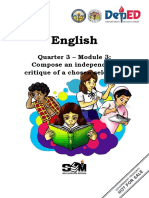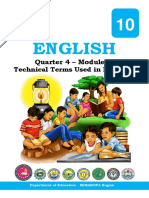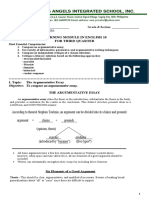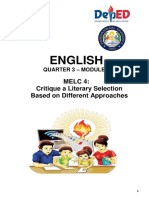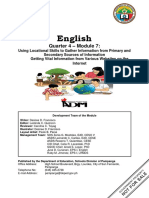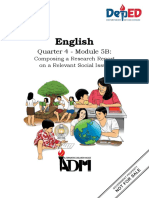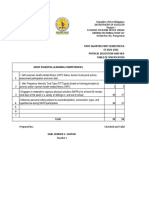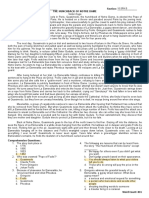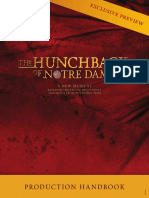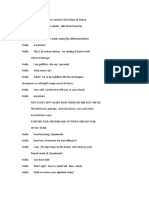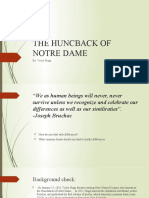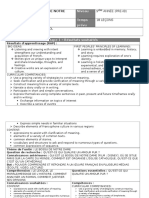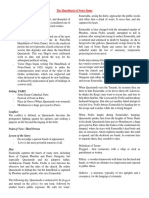Professional Documents
Culture Documents
Grade 10 - Quarter 3 - Module 6
Grade 10 - Quarter 3 - Module 6
Uploaded by
Hajie RosarioOriginal Description:
Copyright
Available Formats
Share this document
Did you find this document useful?
Is this content inappropriate?
Report this DocumentCopyright:
Available Formats
Grade 10 - Quarter 3 - Module 6
Grade 10 - Quarter 3 - Module 6
Uploaded by
Hajie RosarioCopyright:
Available Formats
10
ENGLISH
QUARTER 3 – MODULE 6
MELC 3:
Compose an Independent Critique
of a Chosen Selection
English 10 – Quarter 3 – Module 6 1
What I Know
Directions: Choose the letter of the correct answer. Write your answer on a
separate sheet of paper.
1. The word critique is NOT the same as:
A. review
B. analysis
C. assessment
D. appraisal
2. It is an in-depth evaluation of the story for the purpose of giving the reading
public insight into the story.
A. Critiquing
B. Ending of the story
C. Organizing
D. Elements
3. The following are guides in writing a critique except ONE.
A. grammar
B. content
C. literary devices
D. author’s intention
4. Below are ways on how to write a critique. Which one is NOT applicable?
A. Study the work under discussion.
B. Don’t make notes on key parts of the work.
C. Develop an understanding of the main argument.
D. Consider how the work relates to a broader issue.
5. Speech is an example of:
A. a literary text
B. an essay
C. a drama
D. a myth
English 10 – Quarter 3 – Module 6 2
What Is It
Writing a Critique · describe: give the reader a sense of the writer's overall
purpose and intent · name of author and work ·
When we summarize a text, we capture its main points.
When we analyze a text, we consider how it has been put together- we dissect
it, more or less to see how it works.
When we critique a text, we interrogate it.
Seriously, when we critique, our opinions and ideas are already part of our
textual analysis.
The purpose of writing a critique is to evaluate somebody’s work in order to
increase readers understanding.
Analysis means to breakdown and study the parts.
Evaluation is the most important part in a critical review.
Use the literature to support your views. You may also use your knowledge of
conducting research, and your own experience. Evaluation can be explicit or
implicit.
Explicit evaluation
Explicit evaluation involves stating directly (explicitly) how you intend to
evaluate the text.
e.g. "I will review this article by focusing on the following questions. First, I will
examine the extent to which the authors contribute to current thought on
Second Language Acquisition (SLA) pedagogy. After that, I will analyze whether
the authors' propositions are feasible within overseas SLA classrooms."
Implicit evaluation
Implicit evaluation is less direct. The following section on Linguistic Features of
Writing a Critical Review contains language that evaluates the text.
Here are some additional ideas to consider in critiquing a text.
1. How did you respond to the text?
2. Did you like It? Did it appeal to you?
3. Do you agree with the main ideas?
4. Did the organization make sense?
5. Was the evidence used correctly without manipulation?
6. Is the author objective, biased?
7. Do you agree with the main ideas of the text?
8. Did you find any gaps in the discussion?
9. Has the author left anything out? If yes, was this accidental? Intentional?
10. Are the text tone and language text appropriate?
11. Are the authors’ statements clear?
12. What is the cultural context of the text?
English 10 – Quarter 3 – Module 6 3
CULTURAL CONTEXT is a fancy way which is affected by the ideas and which
stands to lose or gain if the ideas take place. When you think about this, think
of all kinds of social and cultural variables, including age, gender, occupation,
education, race, ethnicity, religion and so forth.
Sample Outline in Writing Critique
I. Background information to help your readers understand the nature of the
work
Title
Author
Publication information
Statement of topic and purpose
Thesis statement indicating writer’s main reaction to the work
II. Summary or description of the work
III. Interpretation and /or evaluation
Discussion of the works organization
Discussion of the work style
Effectiveness
Discussion of the topic treatment
Discussion of appeal in a particular audience
openoregon.pressbooks.pub
What’s More
Now it’s time for you to check your understanding.
Activity 1: Practice makes perfect.
Directions: Arrange the jumbled letters to form the correct word. Write your answer
on a separate sheet of paper.
1. It means to breakdown and study the parts. SNLYASIA
2. One of the purposes of evaluating a text. TEVAULAION
English 10 – Quarter 3 – Module 6 4
3. Helps readers understand the nature of the work. GRNDUOCKAB
FORINITONAM
4. Capturing the main points of a text. SUMMRIZINGA
5. Critical analysis. TICRIQUE
Activity 2: Right With Your Heart
As shown in your previous lesson, an example of a critique was provided for
you. This time, you are going to read another literary text, “THE HUNCHBACK OF
NOTRE DAME.” Write your critical analysis .Follow the sample outline in your
module. Use this text also in answering the Worksheet.
THE HUNCHBACK OF NOTRE DAME
Victor Hugo
During the 1482 Festival of fools in Paris, Quasimodo, the Hunchback of
Notre Dame, is elected the pope of fools for being the ugliest person in Paris. He is
hoisted on a throne and paraded around Paris by the jeering mob. Pierre Gringoire
,a struggling poet and philosopher, tries unsuccessfully to get the crowd to watch
his play instead of the parade. Archdeacon Claude Frollo appears and stops the
parade and order Quasimodo back to Notre Dame with him. Looking for something
to eat, Gringoire admires the graceful beauty of La Esmeralda, a gypsy street
dancer, and decides to follow her home. After rounding a corner, she is suddenly
attacked by Frollo Gringoire and Quasimodo rushes to help her but is knocked out
by Frollo as Frollo Runs away. The King’s Archers, led by Phoebus de Chateaupers
arrive just in time and capture the hunchback. Later that night , a group of beggars
and thieves are about to hang Quasimodo when La Esmeralda comes forward and
offers to save his life by marrying him for four years only.
The next day, Quasimodo is put on trial and sentenced to two hours of
torture in the Place de Greve. He suffers both the pain of being stretched and
pulled apart as well as being publicly humiliated by the crowed of people, who hate
him for his ugliness. He begs for water, but no one answers his pleas until La
Esmeralda comes forth and brings him something to drink. Nearby, a recluse called
Sister Gudule, screams at La Esmeralda for being a “gypsy child thief” and blames
her for her daughter’s kidnapping fifteen years earlier. A few months later, La
Esmeralda is dancing in front of Notre Dame and Phoebus calls her over to him.
She has fallen in love with him and blushes when he asks her to meet him later
that night. Frollo watches them from the top of Notre Dame and becomes insanely
jealous of Phoebus. His obsessive lust for Esmeralda has made him renounce God
and study alchemy and black magic. In his secret cell at Notre Dame, he plans to
trap La Esmeralda like a spider catching a fly with its web. Later that night he
English 10 – Quarter 3 – Module 6 5
follows Phoebus to his tryst with La Esmeralda and stabs Phoebus repeatedly. He
escapes and La Esmeralda is captured by the King’s guard.
After being tortured at her trial, La Esmeralda falsely confesses to killing
Phoebus and being a witch. She is sentenced to hang in the Place de Greve. Frollo
visits her in jail and declares his love. He begs her to love him and show him some
pity but she calls him a “goblin-monk’ and a murderer, refusing to have anything to
do with him. Before her execution, La Esmeralda is publicly humiliated in front of
Notre Dame. Looking across the square, she suddenly sees Phoebus and calls out
his name. He actually survived the murder attempt but doesn’t want anyone to
know that he was injured. He turns away from La Esmeralda and enters the house
of his bride-to-be. Just then, Quasimodo swings down on a rope from Notre Dame
and carries her back to the Cathedral, crying out “Sanctuary!” He had fallen in love
with her when she brought him water and had been planning for escape all along.
La Esmeralda is safe from execution just as long as she stays inside the
Cathedral. At first, she finds it hard to even look at Quasimodo, but they form an
uneasy friendship. Even though he is deaf, he enjoys being around her when she
sings.
Meanwhile, a group of vagabonds resolves to save La Esmeralda after
hearing that Parliament has ordered that she be removed from Notre Dame. But
when Quasimodo sees them attack the Cathedral, he thinks they have come to kill
La Esmeralda and he finds them off as best as he can, killing a large number of
them. Frollo has used the attack as a diversion to sneak La Esmeralda out of the
Cathedral. He offers her two choices: she can either say she loves him or be
hanged. She demands to be executed and he leaves her with sister Gudule. To their
astonishment, they discover that they are mother and daughter. Gudule tries to
protect La Esmeralda, but it is too late.
Back at Notre Dame, Quasimodo goes to off into the distance, he sees the
figure of La Esmeralda in a white dress hanging from the scaffold. He bellows out in
despair and grabs Frollo by the neck. Holding him up in the air, Quasimodo sighs
with grief and then throws Frollo down to his death. .Looking at La Esmeralda
hanging off in the distance and Frollo’s wrangled corpse down below, Quasimodo
cries out: “There is everything I ever loved”. Quasimodo is never seen again. Years
later when a gravedigger stumbles across La Esmeralda” remains, he finds the
skeleton of hunchback curled around her.
English 10 – Quarter 3 – Module 6 6
Assessment
Check it out.
Directions: Choose the letter of the correct answer. Write it on a separate sheet of
paper.
1. Other term of the word CRITIQUE
A. observation
B. critical analysis
C. assessment
D. Summarizing
2. The purposes in writing a critique are the following EXCEPT:
A. to evaluate
B. to analyze
C. to assess
D. to predict
3. It gives the reader a sense of the writer's overall purpose and intent, name of
author and work.
A. Short Story
B. Writing a Critique
C. Essay
D. Argumentative speech
4. It involves stating directly how you intend to evaluate the text.
A. explicit evaluation
B. implicit evaluation
C. evaluation language
D. Conclusion
English 10 – Quarter 3 – Module 6 7
5. When we analyze a text, we have to consider the following EXCEPT:
A. to dissect
B. to interrogate
C. to understand
D. to argue
English 10 – Quarter 3 – Module 6 8
Answer Key
What I Know What’s More
Activity 1: Practice Makes Perfect
1. D
2. A 1. ANALYSIS
3. A 2. EVALUATION
4. B 3. BACKGROUND INFORMATION
5. A 4. SUMMARIZING
5. CRITIQUE
Assessment Activity 2: Right With Your Heart
1. B Answers vary
2. D
3. B
4. A
5. D
References
Almonte, L. R. et al (2015). Celebrating diversity through world literature. Pasig City.
Department of Education.
Modeldmedia.com/features/bgcm-youth-essay-jeremiah.aspx
openoregon.pressbooks.pub
www.ou-edu/writing center/specialized.genre/critiqueLearning
English 10 – Quarter 3 – Module 6 9
RETURN THIS WORKSHEET TO YOUR TEACHER!
English 10 – Quarter 3
MODULE 6 – WORKSHEET
MELC 3: Compose an independent critique of a chosen selection
Name: ___________________________________ Score: _________________________
Grade & Section: __________________________ English Teacher: ________________
I . Direction: Encircle the letter of the correct answer.
1. In what part of Paris is Notre Dame located?
A. The Seine B. The Cité C. The Ville D. The Université
2. Who saves La Esmeralda in front of Notre Dame?
A. Archdeacon Claude Frollo C. Quasimodo
B. A Priest D. Phoebus de Chateaupers
3. What does the word Quasimodo mean?
A. half-man B. half-head C. half-made D. half-baked
4. Where is Pierre Gringoire from?
A. England B. Gonesse C. Paris D. Combray
5. Who is elected Pope of Fools?
A. Quasimodo B. La Esmeralda C. Clopin Troillefou D. Frollo
II. Directions: Read carefully the series of events from the story. Then, arrange them
chronologically by numbering the sentences 1-9.
____ A man shouted at Esmeralda.
____ A man stopped the play.
____ Esmeralda married Gringoire
____ Gringoire found the City of Thieves.
____ Gringoire followed Esmeralda and saw two men attack her.
____ In the evening, Esmeralda started dancing.
____ People chose the Pope of Fools.
____ People took Quasimodo around the city.
____ People went to the Place de Grève to see a play.
English 10 – Quarter 3 – Module 6 10
You might also like
- The Hunchback of Notre Dame (Studio Album Booklet)Document32 pagesThe Hunchback of Notre Dame (Studio Album Booklet)Marcela Nightroad56% (9)
- English: Third Quarter - Week 4 Critiquing A Literary SelectionDocument6 pagesEnglish: Third Quarter - Week 4 Critiquing A Literary SelectionKimi Legson100% (1)
- Eng10 - q3 - Mod1 - Compose An Argumentative EssayDocument19 pagesEng10 - q3 - Mod1 - Compose An Argumentative EssayMary Anne Wenceslao100% (6)
- English: Quarter 4 - Module 2Document21 pagesEnglish: Quarter 4 - Module 2Sharryne Pador Manabat67% (12)
- English 10 Quarter 4 Module 2Document18 pagesEnglish 10 Quarter 4 Module 2Marife Magsino93% (14)
- Quarter 2 Module 3 Formulate A Statement of Opinion or AssertionDocument10 pagesQuarter 2 Module 3 Formulate A Statement of Opinion or AssertionLeoclarence100% (1)
- English10 Q3 Module 2 Lesson 1Document17 pagesEnglish10 Q3 Module 2 Lesson 1Sharryne Pador Manabat50% (4)
- English: Quarter 3 - Module 3: Compose An Independent Critique of A Chosen SelectionDocument24 pagesEnglish: Quarter 3 - Module 3: Compose An Independent Critique of A Chosen SelectionAzhty Mae Alquino Recla69% (13)
- English: Quarter 4 - Module 1Document22 pagesEnglish: Quarter 4 - Module 1Lordiel Faderagao25% (4)
- English 10 Q3 M2 L3Document15 pagesEnglish 10 Q3 M2 L3Marife Magsino75% (8)
- (EDITED) SDO - Navotas - Eng10 - M5 - V3.with RevisionDocument25 pages(EDITED) SDO - Navotas - Eng10 - M5 - V3.with Revisionmarco meduranda67% (3)
- Learning Module in English 10 For Third Quarter: Ms. Kareen B. GelilioDocument15 pagesLearning Module in English 10 For Third Quarter: Ms. Kareen B. Geliliosandy navergas91% (11)
- The Hunchback of NotreDocument10 pagesThe Hunchback of Notremhtn79No ratings yet
- Grade 10 - Quarter 3 - Module 7Document10 pagesGrade 10 - Quarter 3 - Module 7Hajie Rosario100% (10)
- English Activity Sheet: Quarter 3 - MELC 3Document10 pagesEnglish Activity Sheet: Quarter 3 - MELC 3jean carla50% (2)
- English: Department of EducationDocument16 pagesEnglish: Department of EducationGideon Isaac Cabuay100% (2)
- English 10 LAS Q4Document45 pagesEnglish 10 LAS Q4Juvelyn Sajonia100% (2)
- English 10 Q4 Module 4Document20 pagesEnglish 10 Q4 Module 4Azhty Mae Alquino ReclaNo ratings yet
- English: Quarter 4 - Module 3: Giving Expanded Definitions of WordsDocument20 pagesEnglish: Quarter 4 - Module 3: Giving Expanded Definitions of WordsSharryne Pador Manabat0% (1)
- English: Quarter 3 - Module 1: Argumentative EssayDocument33 pagesEnglish: Quarter 3 - Module 1: Argumentative EssayBlessa Marel Caasi100% (4)
- ENGLISH 10 Q4 Expanded DefinitionDocument21 pagesENGLISH 10 Q4 Expanded DefinitionJana Paola AriasNo ratings yet
- Quarter 3 - Module 3: Literary Approaches: EnglishDocument7 pagesQuarter 3 - Module 3: Literary Approaches: Englishjessemar wao100% (1)
- English 10 - Quarter 2 - Module 7Document8 pagesEnglish 10 - Quarter 2 - Module 7Emilio Villafria IV100% (1)
- English: Quarter 3 - Module 7: Critique A Literary Selection Based On The Reader-Response ApproachDocument32 pagesEnglish: Quarter 3 - Module 7: Critique A Literary Selection Based On The Reader-Response ApproachTor Pid100% (1)
- Grade 10 Quarter 3 Module 1 EditedDocument13 pagesGrade 10 Quarter 3 Module 1 EditedSheia Jinx75% (4)
- English 10 Quarter 4 Module 7Document16 pagesEnglish 10 Quarter 4 Module 7Marife Magsino100% (4)
- English: Third Quarter-Module 1 Composing An Argumentative EssayDocument13 pagesEnglish: Third Quarter-Module 1 Composing An Argumentative EssayVinMoroCipriano100% (1)
- Q2 English 10 Module 4Document31 pagesQ2 English 10 Module 4ennax ECNo ratings yet
- English: Quarter 3 - Module 6: Critiquing A Literary Selection Using Structuralism and Formalism ApproachDocument20 pagesEnglish: Quarter 3 - Module 6: Critiquing A Literary Selection Using Structuralism and Formalism ApproachLiezl Sabado70% (10)
- English: Learning Activity SheetsDocument45 pagesEnglish: Learning Activity SheetsSheilavee TaguinodNo ratings yet
- Activity Sheet in English 10: Worksheet No. 4.1, Quarter 4Document6 pagesActivity Sheet in English 10: Worksheet No. 4.1, Quarter 4Dhaiiganda100% (3)
- ENG10-Q3-Module 2 - Lesson 3Document27 pagesENG10-Q3-Module 2 - Lesson 3Ma Ria Liza50% (2)
- English10 Q3 Module 7Document25 pagesEnglish10 Q3 Module 7Jonnah SarmientoNo ratings yet
- ENG10-Q3-Module 2 - Lesson 1Document34 pagesENG10-Q3-Module 2 - Lesson 1Rosenda N. Gulane90% (10)
- English 10 Q4 Module 1Document22 pagesEnglish 10 Q4 Module 1Mary Jane Silva100% (1)
- English 10 Q3 M4Document14 pagesEnglish 10 Q3 M4Trisha Villacorta89% (9)
- Engl10 Q4 M1 DistinguishTechnicalTermsUsedinResearch Pagulongan V0-Module-1Document32 pagesEngl10 Q4 M1 DistinguishTechnicalTermsUsedinResearch Pagulongan V0-Module-1Kath Nees75% (4)
- Eng10 Q3 Melc3&4 CombinedDocument29 pagesEng10 Q3 Melc3&4 CombinedEm-Em Alonsagay Dollosa100% (3)
- English 10 Q3 Week 5Document4 pagesEnglish 10 Q3 Week 5Romnick Dolores100% (1)
- English 10 Summative TestDocument6 pagesEnglish 10 Summative TestKimberly NgNo ratings yet
- English 10 Q1 M5Document12 pagesEnglish 10 Q1 M5Jaymar B. MagtibayNo ratings yet
- English10 Q3 Module 8Document24 pagesEnglish10 Q3 Module 8Jonnah SarmientoNo ratings yet
- SLM E10q3m5Document6 pagesSLM E10q3m5May Dee Rose Kaw-it100% (1)
- English: Quarter 3 Module 2 - Lesson 2Document17 pagesEnglish: Quarter 3 Module 2 - Lesson 2Marife Magsino95% (21)
- English 10 Q4 M4Document15 pagesEnglish 10 Q4 M4mira rochenie67% (3)
- English Activity Sheet: Quarter 3 - MELC 3Document10 pagesEnglish Activity Sheet: Quarter 3 - MELC 3Lily CruzNo ratings yet
- English: Recognizing The Gift of NatureDocument27 pagesEnglish: Recognizing The Gift of NatureJay-ar Rivera0% (2)
- English 10 Q3 M6Document14 pagesEnglish 10 Q3 M6Trisha VillacortaNo ratings yet
- English: Artistic Value of The Structure and Elements of The SelectionDocument16 pagesEnglish: Artistic Value of The Structure and Elements of The SelectionPatricia Tomboc0% (1)
- English: Quarter 2 - Module 1Document12 pagesEnglish: Quarter 2 - Module 1Sarah Jhoy Salonga100% (1)
- English: Quarter 4 - Module 4Document21 pagesEnglish: Quarter 4 - Module 4Sharryne Pador Manabat100% (1)
- English 10 Q3 M2 3Document14 pagesEnglish 10 Q3 M2 3Ysa Joyce BayonaNo ratings yet
- English 10 Q4 Module 2Document18 pagesEnglish 10 Q4 Module 2Mary Jane Silva50% (2)
- English: Quarter 4 - Module 5 Research ReportDocument16 pagesEnglish: Quarter 4 - Module 5 Research ReportCassandra Kaye SanchezNo ratings yet
- Q4 English 10 - Module 2Document30 pagesQ4 English 10 - Module 2Steve MarataNo ratings yet
- Quarter 3: Module 3: Compose An Independent Critique of A Chosen SelectionDocument14 pagesQuarter 3: Module 3: Compose An Independent Critique of A Chosen SelectionClifford Lachica50% (2)
- English10 Q2 Mod1 LanguageofResearchCampaignsandAdvocaciesDocument19 pagesEnglish10 Q2 Mod1 LanguageofResearchCampaignsandAdvocaciesJosephine Bonsol100% (1)
- Quarter 3 Module 1 (ENGLISH 10 SLM)Document5 pagesQuarter 3 Module 1 (ENGLISH 10 SLM)Jessa Mae Anthony100% (2)
- English Activity Sheet: Quarter 3 - MELC 1Document10 pagesEnglish Activity Sheet: Quarter 3 - MELC 1jean carla100% (2)
- English 10: What I Need To KnowDocument14 pagesEnglish 10: What I Need To KnowChelsea MedranoNo ratings yet
- English 10 Quarter 4 Module 6Document19 pagesEnglish 10 Quarter 4 Module 6Marife Magsino63% (8)
- Historical and Readers Response Approaches LPDocument6 pagesHistorical and Readers Response Approaches LPJOPLAKS TV100% (1)
- TOS Q1 Oral Communication in Context SampleDocument1 pageTOS Q1 Oral Communication in Context SampleHajie Rosario100% (1)
- K To 12 Basic Education Program TECHNOLOGY and Livelihood Education Home ECONOMICS Wellness MassageDocument71 pagesK To 12 Basic Education Program TECHNOLOGY and Livelihood Education Home ECONOMICS Wellness MassageHajie RosarioNo ratings yet
- Accomplishment Report in Dental Health Care S.Y 2020 - 2021Document5 pagesAccomplishment Report in Dental Health Care S.Y 2020 - 2021Hajie RosarioNo ratings yet
- First Quarter-First Semester Examination SY 2021-2022 Physical Education and Health - 11 Table of SpecificationDocument2 pagesFirst Quarter-First Semester Examination SY 2021-2022 Physical Education and Health - 11 Table of SpecificationHajie RosarioNo ratings yet
- Graphic Designing: by Hajie RosarioDocument9 pagesGraphic Designing: by Hajie RosarioHajie RosarioNo ratings yet
- School Dental Health Care Program ACTION PLAN S.Y. 2020-2021Document2 pagesSchool Dental Health Care Program ACTION PLAN S.Y. 2020-2021Hajie Rosario100% (1)
- 1st Online Class Sept20Document20 pages1st Online Class Sept20Hajie RosarioNo ratings yet
- Technology and Livelihood Education: Quarter 1 - Module 3Document43 pagesTechnology and Livelihood Education: Quarter 1 - Module 3Hajie RosarioNo ratings yet
- Lesson 2: Planning For The Continuing Professional Development and Participation in The LacDocument2 pagesLesson 2: Planning For The Continuing Professional Development and Participation in The LacHajie RosarioNo ratings yet
- What Photo Camera Should I BuyDocument11 pagesWhat Photo Camera Should I BuyHajie Rosario0% (1)
- The Hunchback of Notre DameDocument1 pageThe Hunchback of Notre DameGeraldine SasotaNo ratings yet
- Hunchback Stage Production1Document6 pagesHunchback Stage Production1Marcela NightroadNo ratings yet
- Drama AnalysisDocument41 pagesDrama AnalysisBella HelenaNo ratings yet
- Grade 10 English Module 2 Lesson 1Document8 pagesGrade 10 English Module 2 Lesson 1Eloisa H. Capinpin50% (2)
- The Hunchback of Notre Dame SummaryDocument2 pagesThe Hunchback of Notre Dame SummaryJeliegh GasminNo ratings yet
- Rezumat Notre Dame de ParisDocument19 pagesRezumat Notre Dame de Pariscatalin_sibiu100% (1)
- The Hunchback of Notre DameDocument4 pagesThe Hunchback of Notre DamerubyangelaNo ratings yet
- Reaction PaperDocument6 pagesReaction PaperAngelyn PlanaNo ratings yet
- 6001-6100 PhoneNumbers 1Document100 pages6001-6100 PhoneNumbers 1Eneo PajoNo ratings yet
- Grade 10 - Quarter 3 - Module 6Document10 pagesGrade 10 - Quarter 3 - Module 6Hajie Rosario50% (10)
- Cot1,2022 2023Document12 pagesCot1,2022 2023Jonalyn Monares100% (1)
- Hunchback Student GHuide PDFDocument88 pagesHunchback Student GHuide PDFSharon AnnNo ratings yet
- The Hunchback of Notre Dame Movie ReviewDocument9 pagesThe Hunchback of Notre Dame Movie Reviewmiraflor madoloraNo ratings yet
- SCRIPTDocument9 pagesSCRIPTJesu EbacuadoNo ratings yet
- English InterventionDocument12 pagesEnglish InterventionJaine CasangcapanNo ratings yet
- The Huncback of Notre Dame: By: Victor HugoDocument8 pagesThe Huncback of Notre Dame: By: Victor HugoMia Jan AmaroNo ratings yet
- Noter DamDocument6 pagesNoter DamAymen Al-badaniNo ratings yet
- The Hunchback of Notre DameDocument112 pagesThe Hunchback of Notre DameMohammad WorldNo ratings yet
- Le Bossu de Notre Dame - Plan DuniteDocument10 pagesLe Bossu de Notre Dame - Plan Duniteapi-306689645No ratings yet
- Of Monsters and MenDocument20 pagesOf Monsters and Menapi-355764630No ratings yet
- The Hunchback of Notre DameDocument1 pageThe Hunchback of Notre DameKiana Marie Fleischer100% (1)
- Arts - Health 9 - Quarter 4 Module 3Document7 pagesArts - Health 9 - Quarter 4 Module 3John Mark PrestozaNo ratings yet
- MOVIE REVIEW - The Hunchback of NotreDameDocument5 pagesMOVIE REVIEW - The Hunchback of NotreDameCecilia-Aint Jaojoco100% (1)
- During The 1482 Festival of Fools in ParisDocument18 pagesDuring The 1482 Festival of Fools in ParisAnusha ShettyNo ratings yet
- Victor Hugo Notre Dame R GreggDocument9 pagesVictor Hugo Notre Dame R Greggrimi_nandyNo ratings yet
- 1williams Melanie The Hunchback of Notre Dame Penguin Kids LeDocument12 pages1williams Melanie The Hunchback of Notre Dame Penguin Kids LeGolden SpeakNo ratings yet
- The Hunckback of Notre DameDocument16 pagesThe Hunckback of Notre DameShaira Mae AngelesNo ratings yet
- Victor Hugo: The Hunchback of Notre DameDocument2 pagesVictor Hugo: The Hunchback of Notre DameMaynard PascualNo ratings yet



